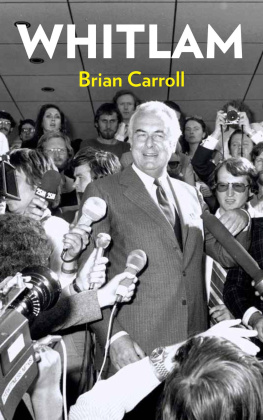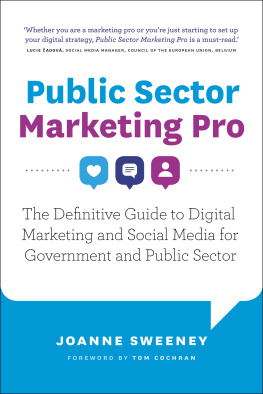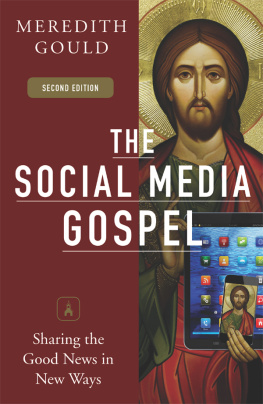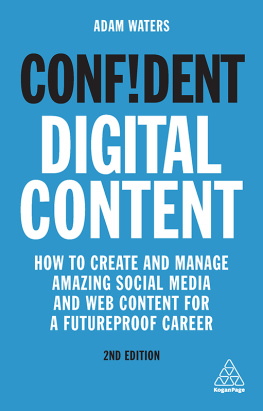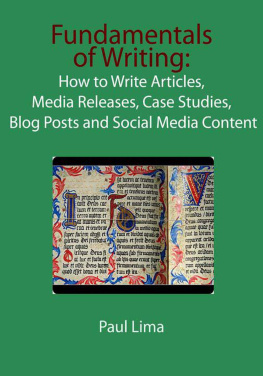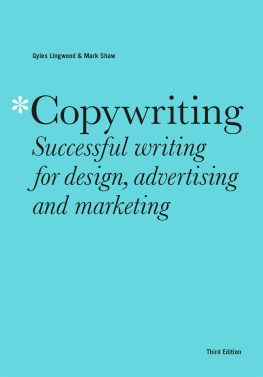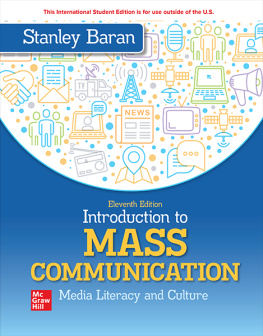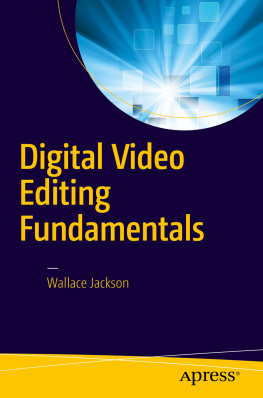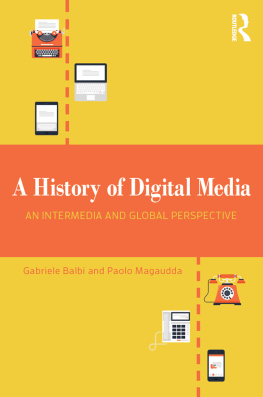Writing and Editing for Digital Media
Writing and Editing for Digital Media teaches students how to write effectively for digital spaceswhether writing for an app, crafting a story for a website, blogging, or using social media to expand the conversation. The lessons and exercises in each chapter help students build a solid understanding of the ways that digital communication has introduced opportunities for dynamic storytelling and multi-directional communication. With this accessible guide and accompanying website, students learn not only to create content, but also to become careful, creative managers of that content.
Updated with contemporary examples and pedagogy, including examples from the 2016 presidential election, and an expanded look at using social media, the third edition broadens its scope, helping digital writers and editors in all fields, including public relations, marketing, and social media management.
Based on Brian Carrolls extensive experience teaching a course of the same name, this revised and updated edition pays particular attention to opportunities presented by the growth of social media and mobile media. Chapters aim to:
- Assist digital communicators in understanding the socially networked, increasingly mobile, always-on, geomapped, personalized media ecosystems;
- Teach communicators to approach storytelling from a multimedia, multi-modal, interactive perspective;
- Provide the basic skill sets of the digital writer and editor, skill sets that transfer across all media and most communication and media industries, and to do so in specifically journalistic and public relations contexts;
- Help communicators to put their audiences first by focusing attention on user experience, user behavior, and engagement with their user bases;
- Teach best practices in the areas of social media strategy, management, and use.
Brian Carroll is Professor of Communication and Chair of the Department of Communication at Berry College, where he has taught since 2003. A former reporter, editor, and photographer, he is also the author of When to Stop the Cheering? The Black Press, the Black Community, and the Integration of Professional Baseball (2007) and A Devils Bargain: The Black Press and Black Baseball, 19151960 (2015). You can find him on the web at cubanxgiants.com.
Writing and Editing for Digital Media
Third Edition
Brian Carroll

Third edition published 2017
by Routledge
711 Third Avenue, New York, NY 10017
and by Routledge
2 Park Square, Milton Park, Abingdon, Oxon OX14 4RN
Routledge is an imprint of the Taylor & Francis Group, an informa business
2017 Taylor & Francis
The right of Brian Carroll to be identified as the author of this work has been asserted by him in accordance with sections 77 and 78 of the Copyright, Designs and Patents Act 1988.
All rights reserved. No part of this book may be reprinted or reproduced or utilised in any form or by any electronic, mechanical, or other means, now known or hereafter invented, including photocopying and recording, or in any information storage or retrieval system, without permission in writing from the publishers.
Trademark notice : Product or corporate names may be trademarks or registered trademarks, and are used only for identification and explanation without intent to infringe.
First edition published 2010 by Routledge
Second edition published 2014 by Routledge
Library of Congress Cataloging-in-Publication Data
Names: Carroll, Brian, 1965 author.
Title: Writing and editing for digital media / Brian Carroll.
Other titles: Writing for digital media
Description: Third edition. | New York : Routledge, 2017. | Includes bibliographical
references and index.
Identifiers: LCCN 2017002788 | ISBN 9781138635982 (hardback) | ISBN 9781138636033 (pbk.)
Subjects: LCSH: Online authorship. | Online journalism.
Classification: LCC PN171.O55 C37 2017 | DDC 302.23/1dc23
LC record available at https://lccn.loc.gov/2017002788
ISBN: 978-1-138-63598-2 (hbk)
ISBN: 978-1-138-63603-3 (pbk)
ISBN: 978-1-315-20626-4 (ebk)
Typeset in Warnock Pro
by Apex CoVantage, LLC
Visit the companion website: www.routledge.com/cw/carroll
Contents
As the first edition of Writing for Digital Media went to press in summer 2009, Apple had just unveiled its first iPads, and the companys latest iPhone was the iPhone 3. As this third edition goes to press, it is affordable, portable virtual reality making headlines, as well as the digitally enabled profusion of fake news in what is being called a post-truth world. Technologys pace of change is breathless, and that makes a book on writing and editing for digital media a bit like chasing the wind. The continuing growth of social media, digitally native forms of storytelling, mobile-first design, and big data are just some of the changes reshaping the digital landscape, and making income and sustainable business models elusive and user-bases unpredictable.
This latest revision of Writing and Editing for Digital Media is a response to these changes, as well as an attempt to expand the applicability of its best practices well beyond journalism into the pedagogies and practices of public relations, social media management, and marketing. Examples and case studies have been updated to take a broader view, one more applicable to these varied industries. The book continues, however, to teach the basic skill sets of the digital writer and editor, skill sets that transfer across all media and most communication and media industries. The approach remains essentially journalistic, especially in terms of craft excellence, because the journalists skill set is also the basic skill set of most communication professionals. The journalists objectives of collecting evidence and crafting a story, too, are shared across communication industries. The Internet has brought communication professionals speed, immediacy, interactivity, boundless capacity, and global reach, as well as new ways to gather, report, and distribute information. It has also brought confusion and a blurring of fact and fiction that bewilders and befuddles.
Pedagogical Goals
With these considerations in mind, the aims of this revised edition are to help writers and editors:
- Better understand the implications of a communication world that is socially networked, geomapped, personalized, mobile, and always on.
- Put their audiences first by focusing attention on user experience, user behavior, and engagement with their user bases.
- Allow the story, the content, to determine form and media choices rather than the other way around.
- Become more experimental and adaptable in a fast-changing media ecosystem by providing them with trends, tools, techniques, and technologies.
- Start, shape, and sustain conversations, user participation, and spreadability.
An important assumption of this book is the blurring of roles, responsibilities, and job titles in an era of disruption, one in which we all are consumers and producers, readers and publishers, leaders and followers. The Internet has made it possible for anyone to publish digitally, as well as to engage even a global audience. New rhetorical possibilities have brought with them both unprecedented opportunity and daunting challenges. Thus, this book attempts to guide students and working professionals through this new converged ecosystem, pointing them toward the best practices and techniques of writing, editing, and storytelling.
Understanding what are increasingly fragmented audiences and exploring how different media behavetheir unique limits and possibilitieswill help students to develop smart content. With this book, students will analyze the technical and rhetorical possibilities of digital spaces, including interactivity; immersive, visual narratives; non-linear storytelling; and user participation and contribution. Embracing change is rarely easy, but it can be exciting and empowering. And the stakes have never been higher.
Next page

